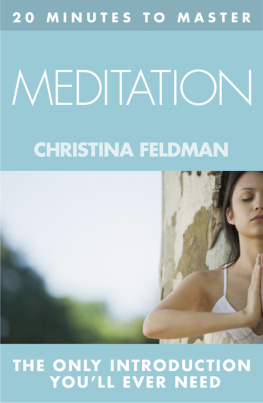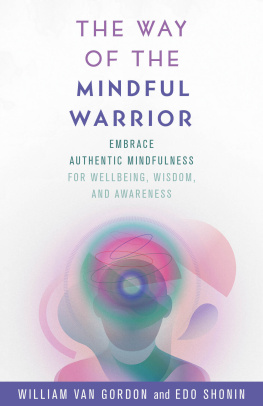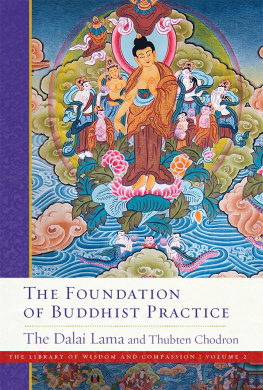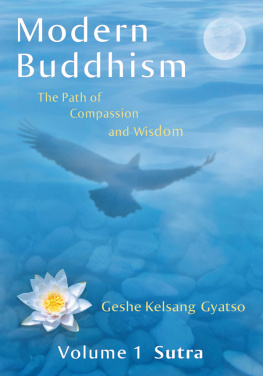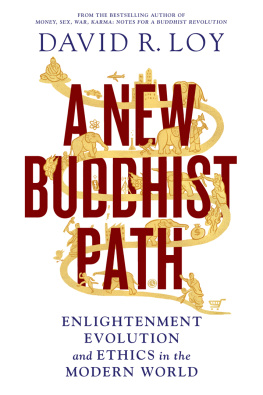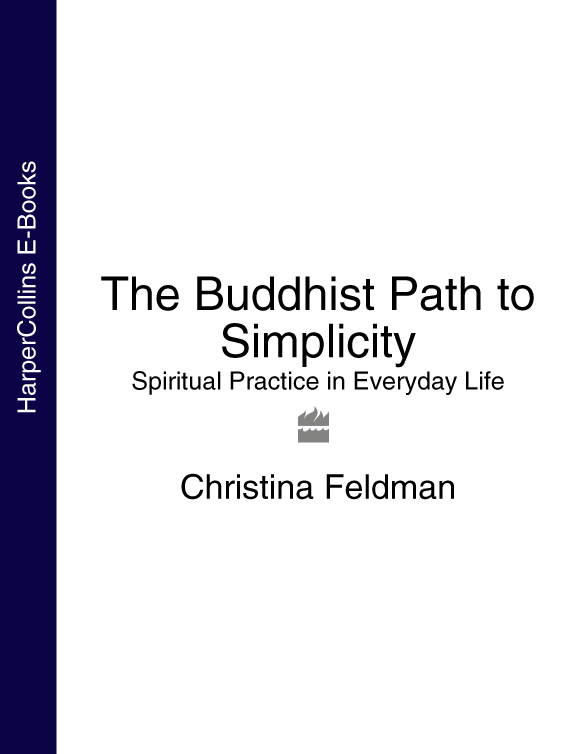
IN our modern consumer society, many people long for greater simplicity and freedom. In a world of strife and conflict, many long for forgiveness and compassion.
You hold in your hands a reminder that this is truly possible. Christina Feldmans gracious invitation to freedom is like the flower held in the hand of the Buddha. She reminds us that the beauty we seek is at hand if only we can remove the dust from our eyes and step out of the palace of illusion.
To do so asks of us a few simple, sacred tasks. To look at the sorrows of the world with eyes of compassion for ourselves and others. To learn the art of trust and letting go. To discover the beauty of the middle way. To remember that like the Buddha, we can rest in a peaceful heart, halfway between heaven and earth, without judging, grasping, or fearing.
From this sacred middle way, we see that we are not separate from all that lives. From this awakened presence, natural care and integrity are born. In any moment this flower of awakening and simplicity beckons to us. May you listen to these words with care and find their truth in your own heart.
JACK KORNFIELD
Spirit Rock Meditation Center
Woodacre, California
2001
We accept the graceful falling
Of mountain cherry blossoms,
But it is much harder for us
To fall away from our own
Attachment to the world
ZEN
WE frequently long for a simpler life, to find those moments when we can sit beneath a tree and listen for one wholehearted moment. We yearn to find the space to attend to our own inner rhythms and messages, the space to reflect upon the direction of our lives and to be touched by the subtle changes of each passing moment. We long to find the space to listen to another person and to our own hearts with total attention. Intuitively, we know these spaces teach us about what is significant, about how to find our path in this world, what nurtures us and how to be touched by the world around us.
Moments of stillness and genuine simplicity offer us glimpses of what it means to live in a sacred and free way. We know we do not need yet more sounds, thoughts, experiences, possessions, or attainments. We have had so many and they fail to quench our thirst for freedom and stillness. They do not make us happier, more free or compassionate. Instead, we discover that the clutter of our lives and minds entangles us in an escalating cycle of haste, alienation, and exhaustion.
In our hearts we know that genuine freedom is much deeper than a permission to have more, accumulate more, or become more. Freedom is the ability to live in such a way that there is no sense of imprisonment. To be free in our lives is to live authentically, embodying creativity, wisdom, and compassion in all dimensions of our lives. Freedom implies a genuine understanding of the source of happiness, the end of despair and conflict. Freedom and simplicity are close companions; simplicity teaches us the ways to release the layers of complexity and confusion that blind us. In their falling away we discover the innate vastness of freedom within us.
We are the most materially affluent of all generations. In pursuit of the good life, we have the possibility of more possessions, attainments, and choices than ever before. We are also a generation of great despair, alienation, and unhappiness. We tend to be hoarders, amassing, accumulating, and gathering endless stockpiles of stuff, inwardly and outwardly, which itself becomes a source of anxiety and tension. The clutter we accumulate, the endless possessions that no longer serve us, the distractions that fill our days, the incomplete conversations and relationships, the long list of things we meant to do, take over our lives, our homes, and our hearts.
There is a story of a wise king who, nearing the end of his life, invited his most devoted subjects to his palace so he could choose an heir. Before the meetings began they were offered fine clothes to dress in, dined on the best of foods, and were entertained by the finest performers. Several hours later, the king asked his attendant to invite his subjects before him so he could question them as to how they would rule the land. Red-faced, the attendant confessed that all the people had gone home. Lost in the pleasures and distractions of the evening they had quite forgotten why they were there.
A path of conscious simplicity teaches us how to recover ourselves and our lives. A new profession of lifestyle advisors has emerged to aid those who find themselves drowning in the clutter and complexity of their lives and hearts. These professionals remind us that having is not the same as happiness and that simplicity may bring the inner space from which authenticity and creativity emerge. Clearly, the meaning of our lives cannot be defined by the accumulation of things and achievements. The meaning of our lives is defined by the quality of our presence in this world and in each moment.
We need to learn how to be our own inner lifestyle consultant. What do we lean upon for security, identity, and reassurance? What are the sources of confusion and unhappiness in our lives? Does the source of happiness lie in the accolades, objects, and attainments we gather or do the roots of genuine happiness lie in our own heart? There are times when it is wise to step back from our preoccupations and listen more deeply to the rhythms and quality of our hearts and minds. In these moments the cultivation of stillness is a great gift of kindness we offer to ourselves. We discover the wisdom of ceasing to externalize the source of happiness, reclaiming instead our own capacity to nurture inner wellbeing and wholeness. In learning to let go of the complexity and busyness in our lives, we are also learning to let go of confusion and agitation.
We have the capacity to shape our lives, and the choices we make directly impact on the quality and well-being of the world; a world that is in dire need of people committed to compassion, integrity, and freedom. Simplicity in our lives expresses respect and care for our world; simplicity in our hearts expresses respect and compassion for ourselves and all living beings.
The search for simplicity is a sacred quest that embraces the many dimensions of our lives and hearts. In seeking simplicity we are not asked to abandon our lives but to reflect on the many strategies, objects, and pursuits that preoccupy us. Do they serve us well? Do they make us more happy or free? What can we let go of, re-examine, complete? It is not enough to unclutter our outer lives and leave intact the restlessness, anxiety, and insecurity at the heart of our confusion. Instead, we are asked to reflect upon our inner lifewhere can we be more mindful, how can we learn to be wholeheartedly attentive, what we need to let go of, what is the source of genuine happiness and freedom.
Our speech, ethics, livelihoods, the efforts we make in our lives, our thoughts, feelings, attitudes, and beliefsthis is our world that asks for wise attention and understanding. Throughout the following chapters, the path of simplicity in the teachings of the Buddha is explored. It is a path of wisdom that teaches us to be a Buddha in our own lives. It is a path of awakening and compassion. The falling away of our layers of confusion and complexity will reveal to us the possibility of a life of freedom and compassion.
A disciple once asked the Buddha to explain the depth and profundity of his teaching. After sitting in silence for a few moments, he simply held up a flower and smiled. We may think of the path to peace and freedom as long, complex, and arduous. Instead, we can simply turn our attention to this moment, this life, and let it speak to us of wonder, mystery, harmony, and peace. There is no better moment in which to awaken and discover everything our heart longs for, than the moment we are in.
Next page

